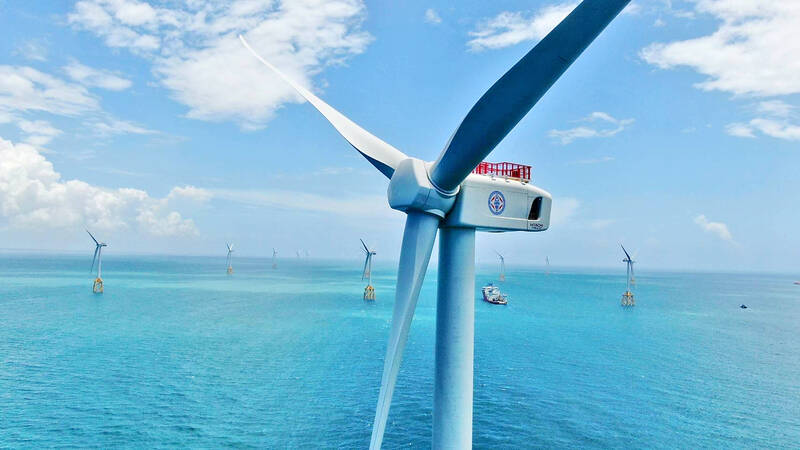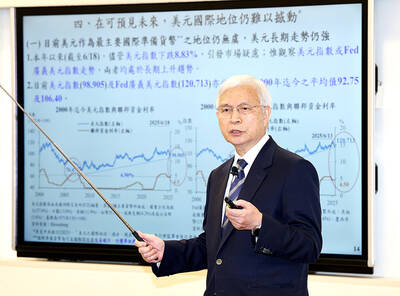Experts from Japan and Taiwan underscored the need to establish communication channels between offshore wind farm developers and fishers, during a two-day APEC conference in Taipei on sustainable marine development.
On Wednesday and Thursday last week, Changhua Fishermen Association secretary Hung Yi-ping (洪一平) and Masanori Miyahara, special advisor to Japan’s Minister of Agriculture, Forestry and Fisheries, discussed their experiences in fisher-wind farm coordination.
Their comments were shared at the 22nd APEC Roundtable Meeting on the Involvement of the Business/Private Sector in the Sustainability of the Marine Environment, held by Taiwan’s Ocean Affairs Council (OAC), during the first session of the conference titled, “Development of Marine Conservation Under Offshore Wind Farm Operations.”

Photo courtesy of Taiwan Power Co
Miyahara said the Japanese government was committed to reducing greenhouse gas emissions by 46 percent by 2030 from 2013 levels, with offshore wind power set to be central to achieving this.
The tender process for offshore wind projects in Japan includes promotion area designation, developer selection and occupancy plan certification, he said.
Japan’s wind farm operators and fishers have a mutually beneficial relationship, and in addition to advocating carbon reduction, Japan’s government has strived to establish communication platforms between the two stakeholders, Miyahara said.
This includes a development model that involved conducting impact assessments for fisheries, compensating the impacts in accordance with related regulations to mitigate possible protest, and an evaluation of competing interests from wind farm development and fishing areas or nearby seafood farms, he said.
Hung said the government has activated energy transition in response to the global roadmap of reaching net zero by 2050 set by the International Energy Agency.
As part of this, Taiwan was aiming to build 10 wind farms off the coast of Changhua County by 2025, he said.
However, the impacts the construction and operation of the wind farms had on the fisheries and ecosystem, such as the vibration, noise and electromagnetic waves generated by the wind turbines, as well as the reduction of fishing areas, have been a source of contention, he added.
Hung agreed with Miyahara that the possible impacts on fisheries caused by developing wind farms must also be taken into consideration.
In addition to the alleviation measures promised in the environmental assessment, such as avoidance, mitigation and compensation, Hung said that wind developers can also set up compensation and cohabitation funds for fisheries or help fisheries build sea farms or transform into patrollers or observers for marine conservation.

DIVIDED VIEWS: Although the Fed agreed on holding rates steady, some officials see no rate cuts for this year, while 10 policymakers foresee two or more cuts There are a lot of unknowns about the outlook for the economy and interest rates, but US Federal Reserve Chair Jerome Powell signaled at least one thing seems certain: Higher prices are coming. Fed policymakers voted unanimously to hold interest rates steady at a range of 4.25 percent to 4.50 percent for a fourth straight meeting on Wednesday, as they await clarity on whether tariffs would leave a one-time or more lasting mark on inflation. Powell said it is still unclear how much of the bill would fall on the shoulders of consumers, but he expects to learn more about tariffs

Meta Platforms Inc offered US$100 million bonuses to OpenAI employees in an unsuccessful bid to poach the ChatGPT maker’s talent and strengthen its own generative artificial intelligence (AI) teams, OpenAI CEO Sam Altman has said. Facebook’s parent company — a competitor of OpenAI — also offered “giant” annual salaries exceeding US$100 million to OpenAI staffers, Altman said in an interview on the Uncapped with Jack Altman podcast released on Tuesday. “It is crazy,” Sam Altman told his brother Jack in the interview. “I’m really happy that at least so far none of our best people have decided to take them

PLANS: MSI is also planning to upgrade its service center in the Netherlands Micro-Star International Co (MSI, 微星) yesterday said it plans to set up a server assembly line at its Poland service center this year at the earliest. The computer and peripherals manufacturer expects that the new server assembly line would shorten transportation times in shipments to European countries, a company spokesperson told the Taipei Times by telephone. MSI manufactures motherboards, graphics cards, notebook computers, servers, optical storage devices and communication devices. The company operates plants in Taiwan and China, and runs a global network of service centers. The company is also considering upgrading its service center in the Netherlands into a

NOT JUSTIFIED: The bank’s governor said there would only be a rate cut if inflation falls below 1.5% and economic conditions deteriorate, which have not been detected The central bank yesterday kept its key interest rates unchanged for a fifth consecutive quarter, aligning with market expectations, while slightly lowering its inflation outlook amid signs of cooling price pressures. The move came after the US Federal Reserve held rates steady overnight, despite pressure from US President Donald Trump to cut borrowing costs. Central bank board members unanimously voted to maintain the discount rate at 2 percent, the secured loan rate at 2.375 percent and the overnight lending rate at 4.25 percent. “We consider the policy decision appropriate, although it suggests tightening leaning after factoring in slackening inflation and stable GDP growth,”